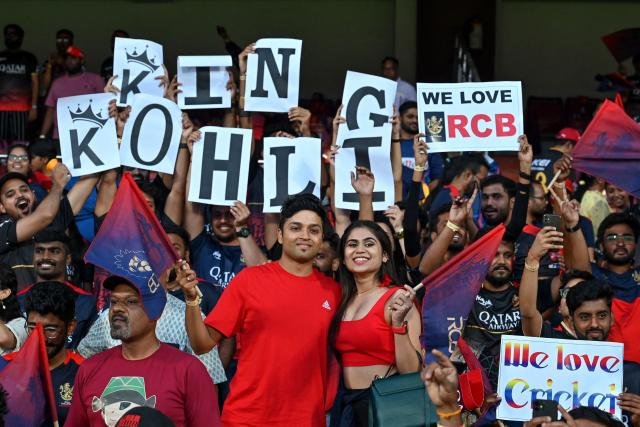Extreme Heat and Hazardous Air - Is the IPL really safe?
By Chris Britt-Searle
We all know that India can be roasting hot and we’ve undoubtedly heard about the terrible air pollution in some of its cities, but what were local conditions like during last year’s IPL matches?
Ahead of the IPL 2025’s opener this weekend, with reigning champions KKR taking on RCB at Eden Gardens, we here at The Next Test decided to take a look back at our findings from 2024’s competition, with sweltering, choking conditions regularly facing the players out in the middle.
Temperatures in °C for IPL host cities on matchdays
According to the data that we gathered, the vast majority of games were played in cities with temperatures above 30°C and one-third were above 35°C. Kolkata even breached the 40°C mark on the 21st April 2024 for KKR vs. RCB.*
A number of cricketers have spoken out recently about playing in extreme heat, notably Pat Cummins, founder of Cricket for Climate and Joe Root, who was hospitalised, as temperatures during the 2018 Ashes test in Sydney soared above 40°C.
“I started Cricket for Climate because I’ve seen first hand how extreme heat and air pollution have affected the game.” Pat Cummins, Australia captain and founder of Cricket for Climate
According to Madeleine Orr’s recent book, Warming Up: How Climate Change is Changing Sport, exertional heat stroke (EHS) is one of the most common causes of death among athletes. Due to the body’s inability to easily lose heat above a certain temperature, it’s when the mercury hits the high 30s that things really become dangerous.
Cricket Australia have heat guidelines in place to protect the players, but the International Cricket Council’s (ICC) current guidelines are decidedly vague. In 2024’s Wisden, former Players Cricket Association chief exec., Rob Lynch is quoted as saying, “I fear it is going to take a tragic incident before the ICC take it seriously… Let’s get ahead of this before something happens.”
Robust heat guidelines are becoming commonplace in other sports, with World Rugby recently announcing new policies and the International Olympic Committee (IOC) deciding to move certain events to alternative cities during the 2020 Tokyo Olympics in order to pre-emptively avoid the heat.
Perhaps even more worrying than the high temperatures during the IPL, though, was the poor air quality that plagued a significant proportion of the matches. In 2023, India ranked as the third worst country in the world for air quality, behind Pakistan and Bangladesh. As you can see from the chart below, almost half of IPL games in 2024 were played in cities with an unhealthy AQI rating (Air Quality Index). This means an AQI rating of over 100, more than twice the maximum safe rating of ‘Good’.
AQI Ratings for IPL host cities on matchdays
Only five games out of a total of 74 were played in conditions of ‘Good’ air quality, and worryingly, five games were played during periods of ‘Very Unhealthy’ air quality, four of those being in Delhi. One match was even played in Delhi, where the air quality that day was rated as ‘Hazardous’ with an AQI of 396; almost 8 times worse than that of ‘Good’.
When the air quality is rated Unhealthy or above, the official advice is to reduce physical activity outdoors, particularly strenuous activity. When the rating is as bad as ‘Hazardous’, the advice is to avoid all physical activity outdoors and to remain indoors and keep activity levels low. How can sport - particularly intense, high level sport, possibly be safe in these conditions?
The 2023 World Cup, held in India, also suffered significant problems with poor air quality. The Bangladesh vs. Sri Lanka game went ahead despite ‘very unhealthy’ air quality conditions, which are a danger even to healthy people. The Delhi air was similarly poor when Sri Lanka played India in a test in 2017, with Sri Lankan players wearing masks and Indian bowler Mohammed Shami vomiting on the pitch.
Sri Lankan players wearing masks during a Test Match in Delhi
Joe Root, after England’s 2023 World Cup game against South Africa in Mumbai, said that he’d never experienced conditions like it. He said, “it just felt like you couldn't get your breath. It was like you were eating the air. It was unique.”
India is by no means alone in suffering the ill effects of our warming, polluted planet. In Australia, a number of sporting events have been cancelled due to bushfire smoke pollution, including a Big Bash League match between Sydney Thunder and Adelaide Strikers. Similarly, in the USA, a whole host of sporting fixtures including baseball, basketball, soccer and football were called off because of wildfire smoke, some of them with air quality ratings significantly lower than that of Delhi during the 2024 IPL.
We here at The Next Test want to make it clear that we are not taking aim at the IPL itself. It is a wonderful carnival of cricket, enjoyed by millions of fans the world over and has been instrumental in making cricket a more dynamic and exciting sport. It has also generated huge investment into the global game and created fantastic opportunities for many players, as well as significant financial windfalls. However, we should not be putting profit before the health of the players.
RCB Fans
The World Health Organisation (WHO) estimates the effects of air pollution are associated with seven million premature deaths every year, globally. The burning of fossil fuels accounts for 3.6 million of those deaths, according to research published in the Proceedings of the National Academy of Science. We cannot ignore the dangers of continuing to play sport in an environment that is becoming increasingly hazardous to human health. If cricket continues to put its players at risk like this, how long will it be before something tragic happens?
Cricket is uniquely vulnerable to the worsening effects of climate change and environmental degradation, but it also has a unique opportunity to take the lead in sustainability and climate action, to inspire its many billions of fans around the world and to be a powerful voice for change.
The Next Test are building a global community of cricket lovers, players, clubs and organisations who are eager for climate action and committed to sustainability in and outside of the sport we love. Sign our pledge and together we can make a difference!
* Data gathered from www.wunderground.com and www.aqi.in. Temperature and air quality data is for the host cities, at the approximate time of the match. The figures given were the maximum reached for that time period.






